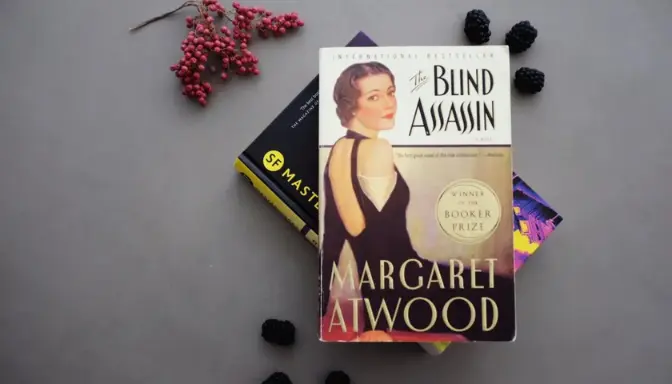Diksia.com - The Blind Assassin is a novel by the Canadian writer Margaret Atwood. It was first published by McClelland and Stewart in 2000. The book is set in the fictional Ontario town of Port Ticonderoga and in Toronto. It is narrated from the present day, referring to previous events that span the twentieth century but mostly the 1930s and 1940s.
It is a work of historical fiction with the major events of Canadian history forming an important backdrop, for example, the On-to-Ottawa Trek and a 1934 Communist rally at Maple Leaf Gardens. Greater verisimilitude is given by a series of newspaper articles commenting on events and on the novel’s characters from a distance. The work was awarded the Booker Prize in 2000 and the Hammett Prize in 2001 and also received a number of other nominations.
Plot summary
The novel’s protagonist, Iris Chase, and her sister Laura, grow up well-off but motherless in a small town in southern Ontario. As an old woman, Iris recalls the events and relationships of her childhood, youth and middle age, including her unhappy marriage to Toronto businessman Richard Griffen. The book includes a novel within a novel, the eponymous Blind Assassin, a roman à clef attributed to Laura but published by Iris.
It is about Alex Thomas, a politically radical author of pulp science fiction who has an ambiguous relationship with the sisters. That embedded story itself contains a third tale, a science fiction story told by Alex’s fictional counterpart to the second novel’s protagonist, believed to be Laura’s fictional counterpart.
The novel takes the form of a gradual revelation illuminating both Iris’s youth and her old age before coming to the pivotal events of her and Laura’s lives around the time of the Second World War. Laura and Iris live in a house called Avilion. Their mother dies at a young age leaving Reenie, the caretaker, to take on full responsibility for the girls.
The Blind Assassin: A novel within a novel
The Blind Assassin is a novel that Laura wrote and Iris published posthumously. It is composed of two narratives: one is a science fiction story set on a planet called Sakiel-Norn, where enslaved children are forced to make carpets until they go blind, and then sold into brothels or become hired assassins.
The other is a love story between a man and a woman who meet in dingy backstreet rooms and tell each other stories. The man is a fugitive writer who is wanted by the authorities for his subversive activities.
The woman is a wealthy socialite who is trapped in a loveless marriage. They use the science fiction story as a way of escaping their reality and expressing their feelings. The novel ends with the woman driving a car off a bridge, killing herself and the manuscript of the novel.
Themes and analysis
The Blind Assassin is a complex and layered novel that explores themes such as memory, truth, identity, power, gender, class, and family. It also examines the role of storytelling and fiction in shaping one’s life and perception of reality.
The novel challenges the reader to question the reliability and motives of the narrator, Iris, who reveals her secrets and lies gradually and selectively. The novel also plays with the genres of historical fiction, mystery, romance, and science fiction, creating a metafictional commentary on the nature and purpose of literature.
The novel also reflects on the social and political changes that occurred in Canada and the world during the twentieth century, such as the Great Depression, the rise of fascism, the Second World War, the Cold War, and the feminist movement.
Reception and legacy
The Blind Assassin received critical acclaim and commercial success upon its publication. It was praised for its intricate plot, rich language, and compelling characters. It was also lauded for its originality and innovation in blending different genres and narratives.
It won the Booker Prize in 2000, becoming the second novel by Atwood to receive the prestigious award, after The Handmaid’s Tale in 1986. It also won the Hammett Prize in 2001, an award given by the International Association of Crime Writers for literary excellence in the field of crime writing.
It was also nominated for the Governor General’s Award, the Orange Prize, and the IMPAC Dublin Literary Award. It was ranked 94th on the BBC’s The Big Read poll in 2003, and 8th on CBC’s Canada Reads in 2011. It was also adapted into a radio drama by the BBC in 2002, and a stage play by Michael O’Brien in 2007.
Conclusion
The Blind Assassin is a novel that showcases the talent and versatility of Margaret Atwood, one of the most celebrated and influential writers of our time. It is a novel that combines mystery and drama, history and science fiction, reality and imagination, to create a captivating and unforgettable reading experience.
It is a novel that challenges and rewards the reader with its intricate structure, rich language, and compelling characters. It is a novel that explores the themes of memory, truth, identity, power, gender, class, and family, and the role of storytelling and fiction in shaping one’s life and perception of reality. It is a novel that deserves to be read and reread, and to be recognized as a masterpiece of contemporary literature.






